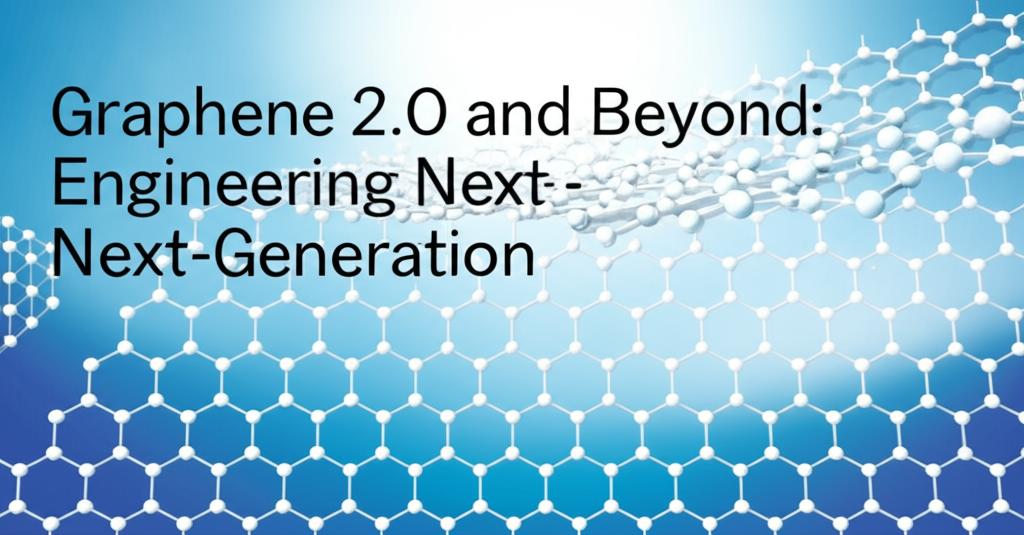Since the groundbreaking isolation of graphene, the field of materials science has been captivated by the potential of two-dimensional (2D) materials. These atomically thin sheets exhibit extraordinary properties distinct from their bulk counterparts, opening doors to revolutionary technologies. While graphene kicked off this exploration, research is rapidly evolving, delving into "Graphene 2.0" – enhanced versions of the original – and a diverse landscape of entirely new 2D materials. Engineering these next-generation materials involves sophisticated synthesis, modification, and integration techniques.
Graphene 2.0: Functionalization for Targeted PerformanceThe term "Graphene 2.0" often refers to functionalized graphene. Pristine graphene, while remarkable, has limitations, such as a zero bandgap which hinders its use in some electronic applications. Functionalization addresses this by chemically modifying the graphene lattice. This involves attaching specific atoms or molecules (functional groups) to graphene's surface or edges, either through strong covalent bonds or weaker non-covalent interactions (like adsorption).
This chemical tailoring allows engineers to fine-tune graphene's properties:
- Introducing a Bandgap: Modifying the structure can open an electronic bandgap, making it suitable for transistors.
- Improving Solubility/Dispersibility: Attaching certain groups makes graphene easier to process in solvents, crucial for inks, composites, and coatings.
- Enhancing Reactivity: Functional groups can serve as anchor points for further chemical reactions or binding sites for specific molecules (e.g., in sensors or drug delivery).
- Targeted Performance Boosts: As seen in commercial applications like advanced bicycle tires, specific functionalization can disproportionately enhance desired traits like grip, durability, speed (lower rolling resistance), or puncture resistance, depending on the application's needs.
Functionalized derivatives like graphene oxide (GO) and reduced graphene oxide (rGO) are key players, offering pathways to large-scale production and diverse applications in electronics, energy storage, composites, biomedical fields, and catalysis.
Beyond Graphene: A Universe of Atomically Thin MaterialsThe limitations of graphene spurred the search for other 2D materials with complementary or entirely different properties. This exploration has unveiled a rich variety of materials:
- Transition Metal Dichalcogenides (TMDs): Compounds like Molybdenum disulfide (MoS2) and Tungsten disulfide (WS2) consist of a transition metal layer sandwiched between two chalcogen layers (like sulfur or selenium). Unlike graphene, TMDs often possess natural, tunable bandgaps, making them ideal for transistors, photodetectors, LEDs, and solar cells. Their mechanical flexibility is also advantageous for bendable electronics.
- MXenes: This large and rapidly growing family consists of 2D transition metal carbides, nitrides, or carbonitrides (formula Mn+1XnTx). Derived by etching layered precursor materials (MAX phases), MXenes often exhibit high metallic conductivity, excellent energy storage capacity (making them stars in batteries and supercapacitors), strong electromagnetic shielding capabilities, and catalytic activity. Their surface chemistry (denoted by 'Tx' - surface terminations like -O, -OH, -F, -Cl) critically influences their properties and can be engineered for specific applications like sensors or water purification. Recent research is even pushing beyond known MXene families, using theoretical prediction combined with synthesis to potentially unlock hundreds of new 2D materials.
- Hexagonal Boron Nitride (hBN): Structurally similar to graphene but composed of boron and nitrogen, hBN is an excellent electrical insulator with high thermal conductivity and stability. It's often used as an ideal substrate or dielectric layer in graphene-based devices or as a protective coating.
- Phosphorene: A single layer of black phosphorus, it boasts a direct bandgap (unlike many TMDs) and highly anisotropic properties (properties differ depending on direction). This makes it interesting for electronics, optoelectronics, and sensors.
- Xenes (Silicene, Germanene, Stanene, etc.): These are single-element 2D materials analogous to graphene but made from silicon, germanium, or tin. They promise easier integration with existing silicon-based electronics but often face stability challenges.
- 2D Metals: A very recent breakthrough involves creating stable, atomically thin layers of traditional metals (like Bismuth) using techniques like "van der Waals (vdW) squeezing." This allows precise control over thickness (mono-, bi-, trilayer) and opens up new frontiers beyond traditional vdW layered materials for quantum, electronic, and photonic devices.
Creating and utilizing these materials involves sophisticated engineering approaches:
- Synthesis: Methods range from traditional exfoliation (peeling layers apart) and chemical vapor deposition (growing films atom by atom) to selective etching (for MXenes) and novel techniques like vdW squeezing. A major challenge remains the scalable, cost-effective production of high-quality, large-area 2D materials.
- Functionalization and Doping: As with Graphene 2.0, chemical modification is crucial across the board for tuning properties and enabling specific applications.
- Heterostructure Engineering: Stacking different 2D materials like atomic Lego blocks creates vdW heterostructures. This allows combining the best properties of multiple materials or generating entirely new emergent phenomena not present in the individual layers.
- Solution Processing and Printing: Developing inks based on 2D materials allows for printing techniques (like inkjet or screen printing) to fabricate thin films, circuits, and devices on various substrates, including flexible ones.
- Computational Guidance: Advanced simulations and machine learning are increasingly used to predict the properties of new or hypothetical 2D materials, understand their behavior, and guide experimental synthesis and device design.
Despite rapid progress, significant challenges remain in realizing the full potential of next-generation 2D materials. These include:
- Achieving reliable large-scale production with consistent quality.
- Ensuring long-term stability, particularly for materials prone to oxidation like MXenes and phosphorene.
- Developing robust methods for integrating 2D materials into complex devices and existing manufacturing workflows.
- Fully understanding and controlling the interfaces within heterostructures.
- Assessing and mitigating potential environmental or health impacts.
However, the outlook is incredibly bright. Continued research, driven by global initiatives and collaborations showcased in conferences like "Graphene and Beyond" and "GrapheneTech," promises further discoveries of novel 2D materials and refined engineering techniques. From ultra-efficient electronics and energy storage solutions to advanced sensors, flexible displays, and new biomedical tools, engineered 2D materials are poised to redefine the boundaries of technology in the coming decades. The journey from Graphene 2.0 to the vast landscape beyond is continuously paving the way for materials designed atom by atom for unprecedented functionality.

